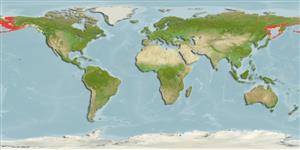分类 / Names
俗名 | 同种异名 | Catalog of Fishes(属, 种) | ITIS | CoL | WoRMS | Cloffa
Teleostei >
Perciformes/Zoarcoidei (Eelpouts and pricklebacks) >
Lumpenidae (Eel pricklebacks)
Etymology: Acantholumpenus: Greek, akantha = thorn + Latin, lumpus = to look disagreable, 1545 (Cyclopterus lumpus) and Latin, lumpus = a uncouth-looking spiny fish of a leaden blue colour; 1545 (Ref. 45335).
More on author: Gilbert.
Environment: milieu / climate zone / depth range / distribution range
生态学
海洋; 半咸淡水 居于水底的; 深度上下限 0 - 200 m (Ref. 56557). ; 70°N - 44°N, 134°E - 120°W
North Pacific: Hokkaido, Japan to the Okhotsk and Bering seas. Arctic Ocean: Arctic coast of Canada.
大小 / 重量 / 年龄
Maturity: Lm ? range ? - ? cm
Max length : 70.0 cm SL 雄鱼/尚未辨别雌雄; (Ref. 559); 最大年龄: 12 年 (Ref. 56557)
背棘 (总数) : 68 - 76; 背的软条 (总数) : 0; 臀棘: 2; 臀鳍软条: 41 - 48. Caudal fin slightly grayish without dark bands; roof of oral cavity with a dark region (Ref. 559). Spines of pelvic and anal fins rigid and easily discernible from other soft rays (Ref. 559). Eye diameter less than snout length (Ref. 559).
Found over mud and sand bottoms to depths of about 56 meters; often in brackish waters (Ref. 51666). Benthic; feeds on worms, crustaceans, sea urchins and molluscs (Ref. 58426).
Life cycle and mating behavior
Maturities | 繁殖 | Spawnings | Egg(s) | Fecundities | 仔鱼
Robins, C.R., R.M. Bailey, C.E. Bond, J.R. Brooker, E.A. Lachner, R.N. Lea and W.B. Scott, 1991. Common and scientific names of fishes from the United States and Canada. Am. Fish. Soc. Spec. Publ. (20):183 p. (Ref. 3814)
人类利用
工具
特别资料
下载 XML
网络资源
Estimates based on models
Preferred temperature (Ref.
123201): -1.5 - 5.6, mean 0.2 °C (based on 1195 cells).
Phylogenetic diversity index (Ref.
82804): PD
50 = 1.0000 [Uniqueness, from 0.5 = low to 2.0 = high].
Bayesian length-weight: a=0.00263 (0.00144 - 0.00479), b=2.91 (2.75 - 3.07), in cm total length, based on LWR estimates for this species & (Sub)family-body (Ref.
93245).
营养阶层 (Ref.
69278): 3.1 ±0.2 se; based on diet studies.
回复力 (Ref.
120179): 低的, 最小族群倍增时间4.5 - 14 年 (Preliminary K or Fecundity.).
Fishing Vulnerability (Ref.
59153): Moderate to high vulnerability (54 of 100).
